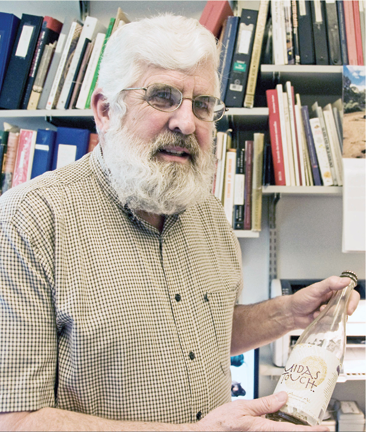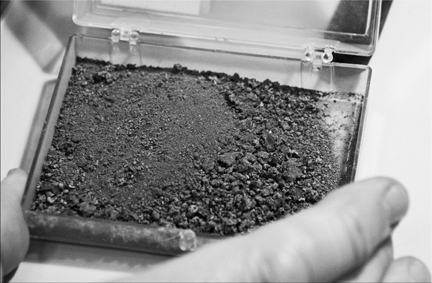
University of Pennsylvania Professor Patrick McGovern has sometimes been referred to as the "Indiana Jones of Ancient Ales, Wines, and Extreme Beverages. | Photo © Katharine Gilbert
By Barbara Nolan
The box full of 2,700-year old dust was quite full, brimming with a golden-looking powdery substance. Its appearance was quite fitting, since it came from drinking vessels inside the tomb of the legendary King Midas (or perhaps his father) who was buried several millennia ago at the site of Gordion in what is now modern Turkey.
The “gold dust,” which might well have gotten its color from saffron, was all that remained of the mixed beverage of wine, beer and mead that had been poured the day the king was laid to rest.
I was sitting in the University of Pennsylvania Museum with Patrick McGovern, who could be described as a man intoxicated by alcohol, although not in the usual sense. Indeed, his quiet demeanor belies his intense interest in the history of the relationship between humans and hard drink, a relationship which, he believes, has shaped the most fundamental aspects of human life down through the millennia.
Although he’s sometimes referred to as the “Indiana Jones of Ancient Ales, Wines, and Extreme Beverages,” McGovern, professor of Anthropology at the University of Pennsylvania, has none of that character’s bumbling disingenuousness. When it comes to alcohol, he’s perfectly serious.
“Fermentation,” says McGovern, who’s also Scientific Director of the Biomolecular Archaeology Laboratory for Cuisine, Fermented Beverages, and Health at the University of Pennsylvania Museum, “is at the basis of life on this planet. All animals are interested in sugar and alcohol, including humans.”
McGovern even goes so far as to contend that our ancestors’ love of beer— which stretches back at least nine thousand years — was the driving force behind the evolution of agriculture in the ancient Near East, as humans learned to store and augment their supplies of the grains from which they produced their heady — and nutritious — brews. Certainly, he says, the development of corn beer in South America initiated the domestication of maize, and fundamentally altered the grain, which had previously been an extremely small cob with a few kernels.
Rather than echo the traditional American wariness of alcohol’s potentially destructive effects, he points out that it has been used since time immemorial as a “universal medicine.”
And he’s firm on the importance of both beer and wine in the human religious experience. “In the process of fermentation itself…it’s like there is some sort of magical force at work. It became very central to most cultures around the world…Christianity, Judaism – wine is right there at the center,” he says, before turning to a discussion of the putative role of wine in the Eleusinian mysteries, as an intermediary between the living and the dead in Chinese ritual, and as an important feature in ceremonial burials from the Homeric Era.
When asked how he became interested in the study of antiquity in the first place, he becomes almost impatient, as if to have to explain his abiding passion would almost be a disservice to it. “I’m interested,” he says, “in why we’re here on this planet.”

Golden powdery residue taken from ancient drinking vessels in what is now modern Turkey. | Photo © Katharine Gilbert
McGovern, who has both Irish and Norwegian ancestry and grew up familiar with the dichotomy between the German and the Gael, speaks of the Irish as an “intellectual, poetic race.”
But he himself does not confine his study of the human love affair with alcohol to the purely intellectual. Although he has written a great deal on the subject, most recently in Uncorking the Past: the Quest for Wine, Beer, and Other Alcoholic Beverages (University of California Press, 2010) McGovern has not been content to leave the past on the bookshelf.
For him, bringing the past back to life has become an avocation. In conjunction with Dogfish Head Craft Brewery of Milton and Rehoboth Beach, DE, Professor McGovern has created a line of extreme beers based on ancient recipes.
With names like Midas Touch (an award-winning honey-based ale with muscat grapes and saffron based on a chemical analysis of the residue in his office), Chateau Jiahu (a rice beer based on residue from 9,000-year-old pottery vessels in northern China), and Theobroma (based on finding some of the earliest chocolate in the New World, c. 1400 BC from Honduras, and yes, it does have both chilies and cocoa in it), these brews have brought him the acclaim of many who have no interest in archaeology.
Ever been curious about what the past tasted like on our ancestors’ tongues? Thanks to Patrick McGovern, you can come very close to finding out.
Did You Know
- That the earliest chemically attested grape wine was found in Iran (ca. 5400 B.C.), a country that prohibits the drink today.
- That curious horse-shoe features (Gaelic fulachta fiadh, “wild pit”), scattered throughout Ireland and dated from Neolithic times down to around 500 B.C., might well have been used to produce the earliest Irish beer, a kind of proto-Guinness.
- That women were the fermented-beverage makers of antiquity, around the world.
